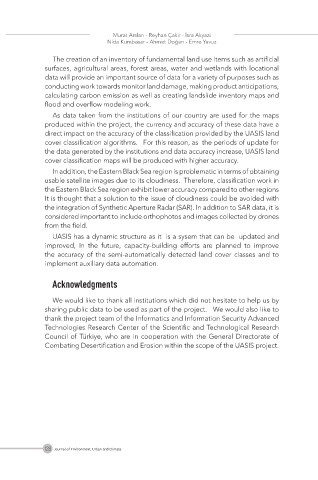Page 141 - Çevre Şehir ve İklim Dergisi İngilizce - Özel Sayı
P. 141
Murat Arslan - Reyhan Çakir - İsra Akyazi
Nida Kumbasar - Ahmet Doğan - Emre Yavuz
The creation of an inventory of fundamental land use items such as artificial
surfaces, agricultural areas, forest areas, water and wetlands with locational
data will provide an important source of data for a variety of purposes such as
conducting work towards monitor land damage, making product anticipations,
calculating carbon emission as well as creating landslide inventory maps and
flood and overflow modeling work.
As data taken from the institutions of our country are used for the maps
produced within the project, the currency and accuracy of these data have a
direct impact on the accuracy of the classification provided by the UASIS land
cover classification algorithms. For this reason, as the periods of update for
the data generated by the institutions and data accuracy increase, UASIS land
cover classification maps will be produced with higher accuracy.
In addition, the Eastern Black Sea region is problematic in terms of obtaining
usable satellite images due to its cloudiness. Therefore, classification work in
the Eastern Black Sea region exhibit lower accuracy compared to other regions
It is thought that a solution to the issue of cloudiness could be avoided with
the integration of Synthetic Aperture Radar (SAR). In addition to SAR data, it is
considered important to include orthophotos and images collected by drones
from the field.
UASIS has a dynamic structure as it is a sysem that can be updated and
improved, In the future, capacity-building efforts are planned to improve
the accuracy of the semi-automatically detected land cover classes and to
implement auxiliary data automation.
Acknowledgments
We would like to thank all institutions which did not hesitate to help us by
sharing public data to be used as part of the project. We would also like to
thank the project team of the Informatics and Information Security Advanced
Technologies Research Center of the Scientific and Technological Research
Council of Türkiye, who are in cooperation with the General Directorate of
Combating Desertification and Erosion within the scope of the UASIS project.
128 Journal of Environment, Urban and Climate

